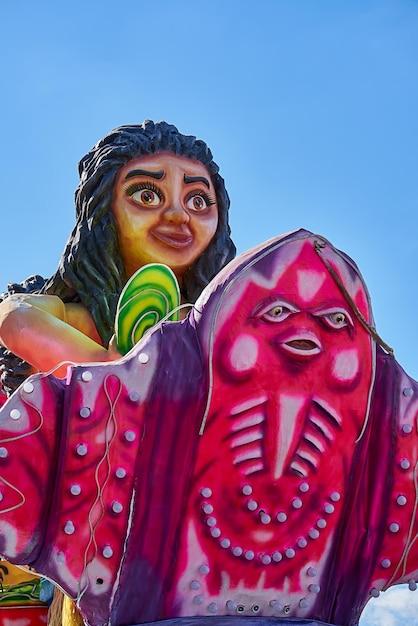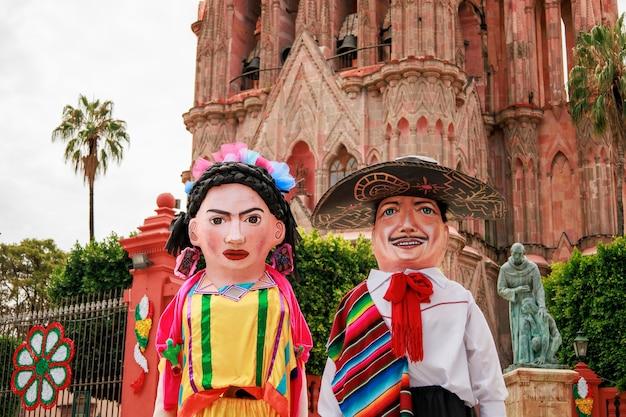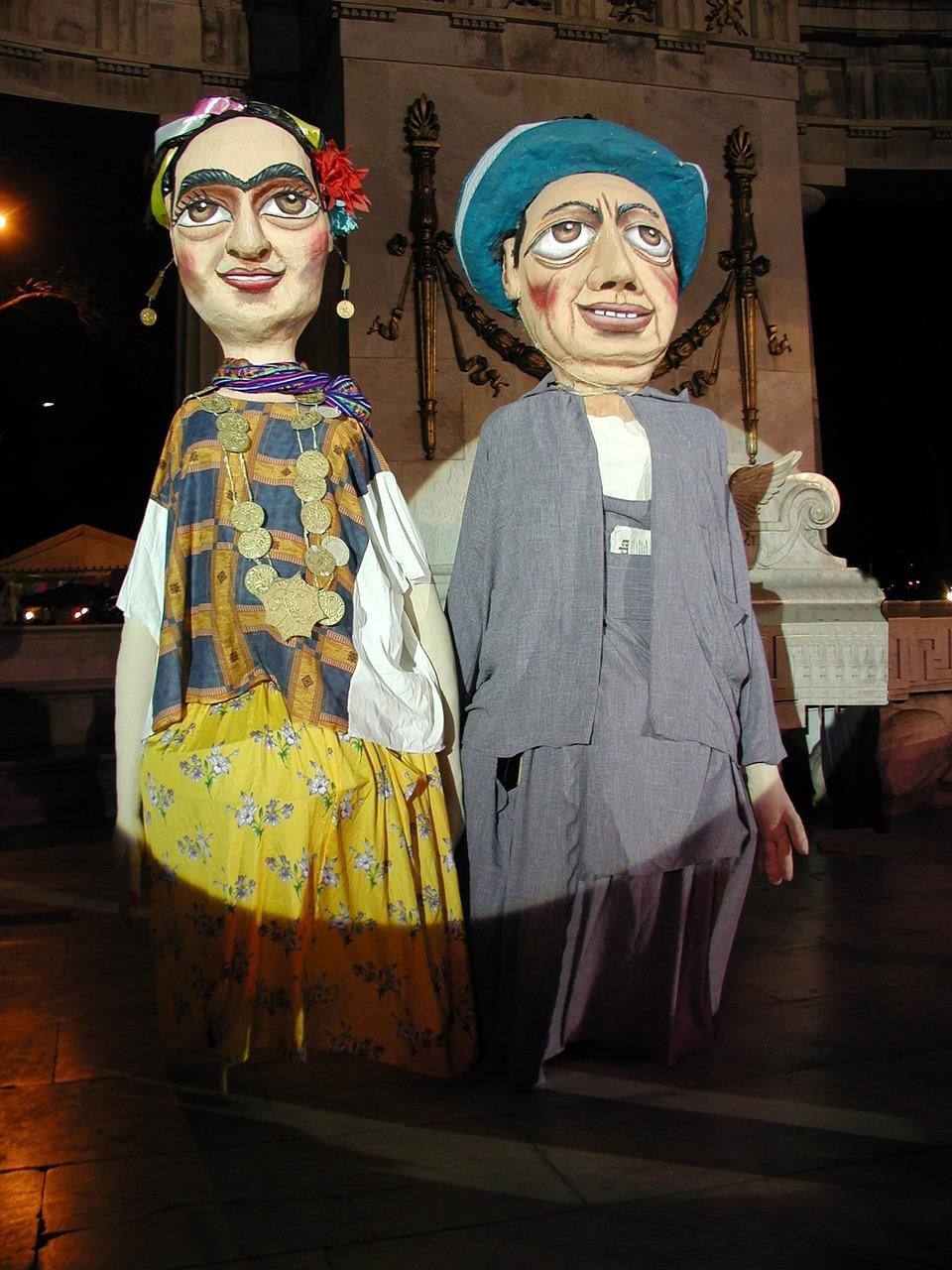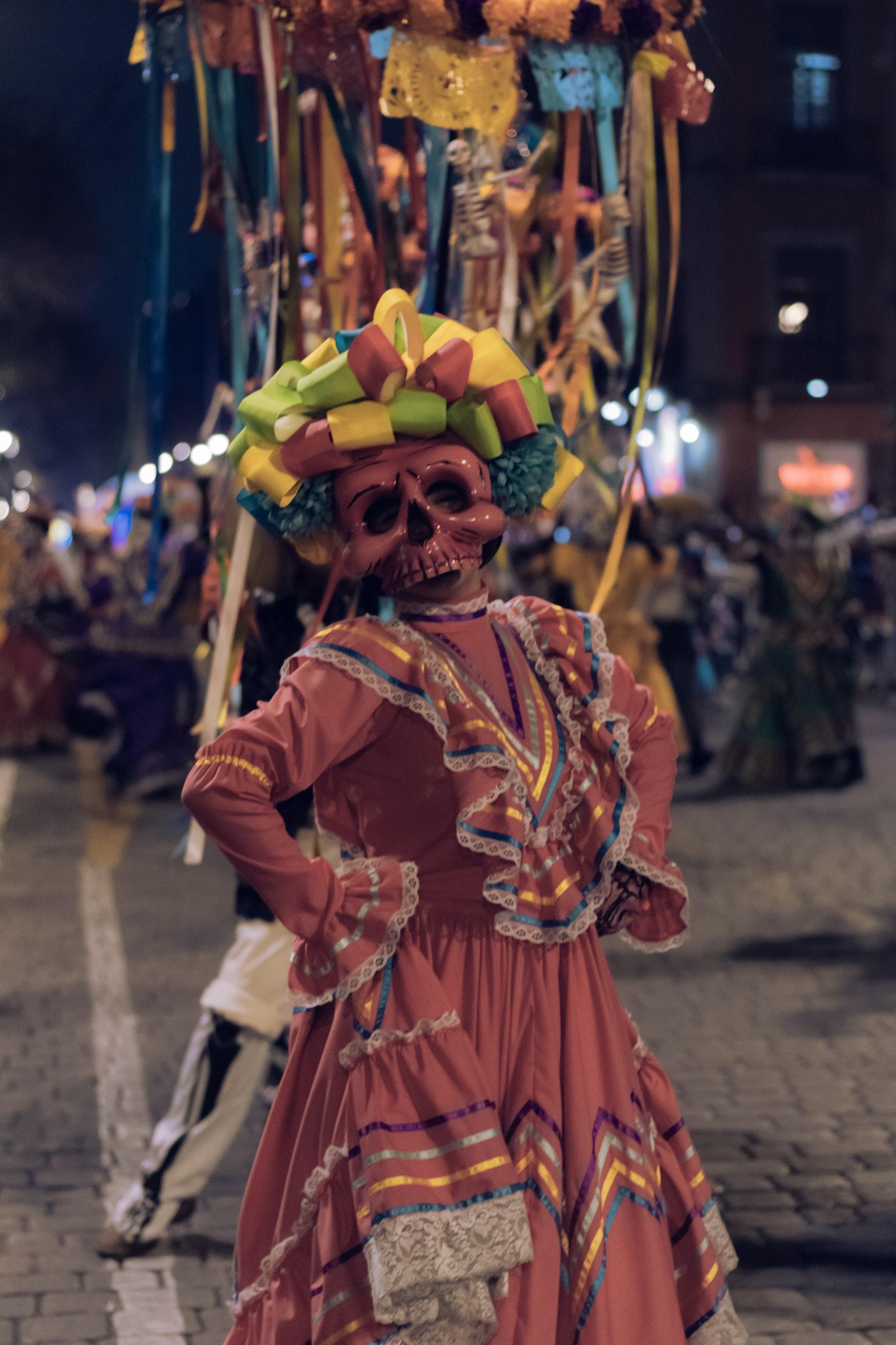Mexico is famous for its vibrant and diverse culture, which is reflected in its art, music, and festivals. Among these festivals, Mojigangas stand out as a unique and colorful tradition that has been celebrated for centuries. These giant puppets, also known as “monos de calenda” or “gigantes” can be seen in many parts of Mexico, but they hold a special place in the hearts of the locals in San Miguel de Allende and Nayarit. This blog post will unveil the history, the making, and the significance of these Mojigangas- the big puppets that represent Mexican culture at its best.
The Marvelous World of Mojigangas
If you are a fan of traditional Mexican festivals, then you have probably heard of mojigangas. These giant, colorful puppets have been a fixture of Mexican celebrations for centuries. If you haven’t seen a mojiganga before, imagine larger-than-life puppets with headdresses, brightly colored clothes and giant paper mache heads.
A Brief History of Mojigangas
The word “mojiganga” comes from the old Spanish word “mojigato,” which means “pious” or “morally righteous.” The original mojigangas were used by Spanish missionaries to teach Native Americans about Catholicism. However, over time, they became part of Mexican culture and eventually, they were used more for entertainment than anything else.
How Are Mojigangas Made
Mojigangas are typically made with papier-mâché, paper, glue, and wire. They are constructed in sections, with the arms and legs attached with wire and the head attached separately. Once the sections are complete, the mojiganga is painted and dressed in colorful clothes.
Using Mojigangas in Celebrations
Mojigangas are often used as part of parades during Mexican festivals. They are used to represent religious or natural figures, and they are accompanied by music and dancers. The performers who operate the mojigangas wear bright clothing and dance in sync with the puppet’s movements.
Modern-Day Mojigangas
Today, mojigangas are still an essential part of Mexican culture. Many communities across Mexico have their own unique designs and variations, making it a diverse tradition. Mojigangas have also been used in advertising and branding campaigns, such as tourism and cultural events.
If you ever have the opportunity to witness a mojiganga performance, take it! It’s truly a unique and colorful experience. These expressive figures embody the rich cultural heritage of Mexico, and they play a vital role in many Mexican festivals and celebrations.
Callejoneada: Exploring the Vibrant Streets of Mexico
Looking for an exciting and memorable way to explore the colorful streets of Mexico? Look no further than callejoneadas! This lively tradition involves a walking tour through the city streets accompanied by a group of musicians, leading you to different neighborhoods and landmarks while entertaining you with lively music.
History of Callejoneadas
The tradition of callejoneadas originates from the colonial-era universities of Mexico. Students would gather and sing folk songs while parading through the streets. Over time, this tradition evolved into a form of entertainment enjoyed by local residents and tourists alike.
Joining a Callejoneada
If you’re interested in joining a callejoneada, you can easily find one through a local tour company or by asking at your hotel or hostel. The tour typically lasts around two hours and involves stops at various attractions and landmarks throughout the city.
The Music of Callejoneadas
Callejoneadas are known for their lively, upbeat music, provided by a group of musicians who accompany the walking tour. The music is typically played on traditional instruments like guitars, violins, trumpets, and maracas, and the songs range from traditional folk tunes to modern pop hits.
Dressing Up for Callejoneadas
Part of the fun of joining a callejoneada is dressing up in traditional Mexican attire. You’ll often see participants wearing colorful dresses, embroidered shirts, and sombreros. If you don’t have your own traditional outfit, many tour companies will provide one for you.
What to Expect
Callejoneadas are a lively, festive, and memorable way to explore the vibrant streets of Mexico. You’ll meet new people, learn about the history and culture of the city, and make memories that will last a lifetime. So put on your dancing shoes and get ready for an unforgettable adventure!
Mojiganga Nayarit: The Wild Side of Mexican Festivals
If you’re a fan of wild, colorful Mexican festivals, then you won’t want to miss the Mojiganga Nayarit! This festival is like no other, with its unique blend of traditional Mexican culture and modern fun.
The History of Mojiganga Nayarit
Mojiganga Nayarit originated in the state of Nayarit, located on the Pacific coast of Mexico. The festival combines elements of traditional Mexican festivals with a more modern, playful spirit, making it a great event for people of all ages.
What to Expect at Mojiganga Nayarit
The festival usually takes place in February or March and lasts for several days. During this time, the streets come alive with dancing, music, and colorful costumes. Mojiganga Nayarit is famous for its elaborate paper-mache figures, which are paraded through the streets by performers dressed in equally flamboyant outfits.
Other highlights of the festival include traditional music and dance performances, food stalls selling local specialties, and various funfair attractions, such as carnival rides and games.
Tips for Enjoying Mojiganga Nayarit
If you’re planning on attending the festival, be sure to wear comfortable shoes, as there will be plenty of walking and dancing involved. It’s also a good idea to bring a hat and sunscreen, as the festival takes place outdoors, and temperatures can be hot.
Finally, be sure to bring your camera or smartphone along so that you can capture all the colorful sights and sounds of the festival. Mojiganga Nayarit is a celebration of Mexican culture and a great reminder of the joy and fun that can be found in even the busiest of cities. Don’t miss out on this unforgettable event!
How to Make a Mojiganga
Mojiganga is a fun and creative way to celebrate any festive event. If you’ve ever seen a giant puppet wandering around on the street, you’ve probably witnessed a Mojiganga in action. Making a Mojiganga isn’t rocket science, but it requires a bit of creativity, patience, and attention to detail. Here’s how you can make your own Mojiganga.
Materials
To make a Mojiganga, you’ll need a few basic materials:
- A frame or structure made of bamboo or wire
- Paper mache or other materials for the body
- Paint, fabric, and other decorations
- Optional: a mechanism to operate the puppet (like handles or strings)
Step-by-Step Instructions
-
Start by creating a design for your Mojiganga. Will it be human-like, animal-like, or something entirely different? Think about the colors, shapes, and decorations you want to use.
-
Once you have a design, create the frame or structure for your Mojiganga. Use bamboo or wire to create the skeleton of your puppet. This will give it shape and stability.
-
Next, create the body of your Mojiganga. Use paper mache or other materials to create the body of your puppet. Use newspapers or other materials to create the skin. Cover the frame and let it dry.
-
When your paper mache is dry, it’s time to decorate your Mojiganga. Use paint, fabric, or other decorations to bring your puppet to life. Add colorful clothes, hats, and other accessories. Let your imagination run wild!
-
If you want to operate your Mojiganga, attach handles or strings to it. Depending on how you want to use your puppet, you may need to attach strings so you can move it.
Making a Mojiganga can be a fun and rewarding experience. It’s a great way to create something unique and memorable. Remember to take your time and be creative. Use the materials you have available and don’t be afraid to experiment. With a little creativity and patience, you can create a Mojiganga that’s sure to delight anyone who sees it.
Mojigangas San Miguel de Allende
Located in central Mexico, San Miguel de Allende is a picturesque town known for its cobblestone streets, colonial architecture, and vibrant cultural offerings. One of the city’s most beloved traditions is its Mojigangas, which are giant paper mache puppets that strut through the streets during festive occasions.
The History of Mojigangas in San Miguel de Allende
Mojigangas have been a part of San Miguel de Allende’s cultural fabric for over 200 years. Originally introduced by Spanish missionaries, the puppets quickly became a hit with the locals, who used them to parody prominent figures and institutions. Today, the tradition remains a vibrant part of the city’s social calendar, featuring prominently in parades and festivals.
How Mojigangas Are Made
Crafting a mojiganga is no easy feat. It involves several layers of newspaper or mixed paper and paste; after drying, the puppet is decorated with paint, clothing, and accessories. The task can take several days or weeks to complete, depending on the level of detail. In San Miguel de Allende, it’s not uncommon for families to pass down the art of mojiganga-making from generation to generation.
The Role of Mojigangas in San Miguel de Allende Culture
Mojigangas are more than just colorful puppets bouncing down the street; they are an expression of the culture, history, and values of San Miguel de Allende. These puppets often depict famous characters from Mexican history, folk tales, and contemporary culture.
Where to See Mojigangas in San Miguel de Allende
The best time to see the mojigangas in action is during one of San Miguel de Allende’s many festivals or parades. The largest of these is the annual Alborada celebration, which takes place in late September and early October. Here, mojigangas can be seen joined by thousands of revelers for a raucous, all-night party.
The Magic of Mojigangas
Mojigangas are a captivating element of San Miguel de Allende’s rich cultural heritage. Much more than mere puppets, they represent a history of creativity, ingenuity, and community that continues to thrive in modern times. If you find yourself in central Mexico, make sure to catch a glimpse of these lively, outsize figures as they dance down the streets, bringing a touch of magic to all who witness them.
Significance of Mojigangas
Mojigangas are not just puppets, they play an essential role in Mexican culture. Here are some of the significant roles Mojigangas play:
Entertainment
Mojigangas are used for entertainment purposes in festivals, street carnivals, and other celebrations. People perform dances, skits, and jokes with the puppets. Their comical and exaggerated features make them popular among children and adults, alike.
Cultural Preservation
Mojigangas have been a part of Mexican culture for centuries as they have played a significant role in preserving Mexican culture. The themes of Mojigangas often depict Mexican history, folklore, and traditions.
Political Commentary
Often seen in political rallies and movements, Mojigangas play a crucial role in expressing political opinions and commentary. They are used to bring attention to social and economic issues, making them a popular tool for activists and community organizers.
Religious Festivals
Mojigangas are used in religious festivals, particularly in the celebration of the Day of the Dead. They represent spirits and departed souls and are a symbol of the Mexican belief that death is not the end, but merely the beginning of a new life.
Tourism
Mojigangas are popular among tourists, which is why they’re often sold as souvenirs. They’re also used to attract foreign visitors to local cultural festivals and events, helping to promote Mexican culture around the world.
Overall, Mojigangas are essential for Mexican culture, playing a crucial role in preserving traditions, expressing political opinions, and, most importantly, providing entertainment at celebrations and festivals.
What are the Big Puppets in San Miguel de Allende
If you’ve ever wandered the streets of San Miguel de Allende, you might have come across some giant, colorful, and often downright bizarre-looking puppets called mojigangas. These big-headed puppets are a staple of street festivals and celebrations in this charming Mexican town. But what are they, and where do they come from?
A Long History
Mojigangas have a long history in Mexico, dating back to the colonial era. They were originally used in religious processions and celebrations, where they represented various saints and biblical figures. Over time, they began to evolve into more secular forms, and today, they are used to represent everything from animals and mythical creatures to political figures and celebrities.
A Big Presence
One thing that immediately stands out about mojigangas is their size. Most are several feet tall, and some can reach up to 15 feet in height! They are made from a variety of materials, including papier-mâché, wood, and wire. Despite their size, they are surprisingly nimble, and puppeteers can manipulate them to perform a wide range of movements and gestures.
A Festive Spirit
Mojigangas are an integral part of the festive spirit of San Miguel de Allende. They appear in parades and processions throughout the year, but are particularly prominent during major holidays like Carnival and Day of the Dead. Each mojiganga is unique, and many are made specifically for a particular event or celebration.
A Symbol of Mexican Culture
Ultimately, mojigangas are a symbol of Mexican culture and the vibrant, colorful spirit that defines this country. They are a unique and beloved tradition that has been passed down through generations, and are a testament to the creativity, talent, and craftsmanship of the people of San Miguel de Allende.
In conclusion, mojigangas are big, bold, and beautiful, and are sure to capture the imagination of anyone who sees them. Whether you’re a first-time visitor to San Miguel de Allende or a seasoned veteran, keep an eye out for these magical puppets, and join in the festive spirit that they embody.



